Fort Street High School
Fort Street High School (FSHS) is a government-funded co-educational academically selective secondary day school, located in Petersham, an inner western suburb of Sydney, New South Wales, Australia. Established in 1849, it is the oldest government high school in Australia, notably the first school not founded by a religious organisation.[3][4] Today, it remains a public school operated by the New South Wales Department of Education. As an academically selective secondary school, it draws students from across greater metropolitan Sydney.
| Fort Street High School | |
|---|---|
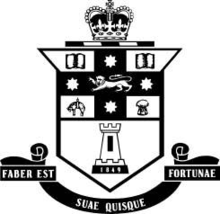 | |
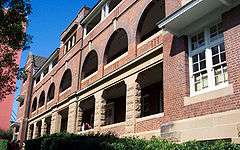 The Wilkins building of the present Fort Street High School | |
| Location | |
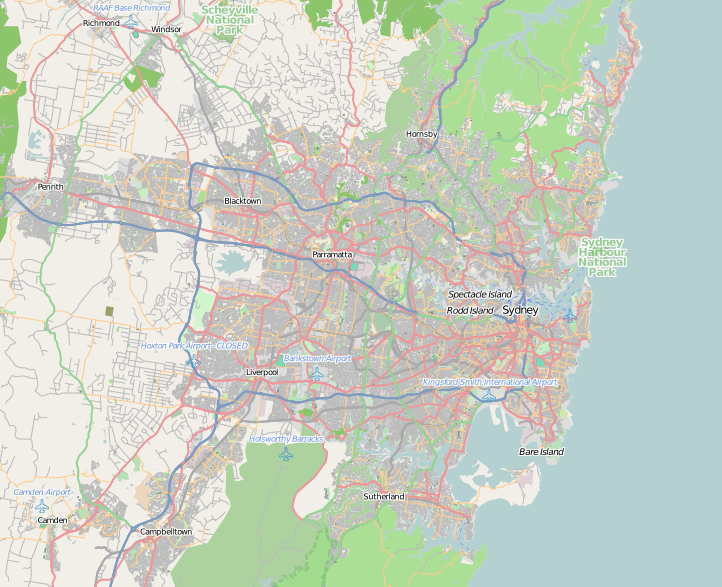 Fort Street High School Location in greater metropolitan Sydney | |
Australia | |
| Coordinates | 33°53′24″S 151°9′10″E |
| Information | |
| Other name | Fort Street High School, Petersham |
| Former name | Fort Street Model School |
| Type | Government-funded co-educational academically selective secondary day school |
| Motto | Latin: Faber est suae quisque fortunae (Each person is the maker of their own fortune) |
| Established | 1849 |
| Sister school | Suginami Sogo High School, Tokyo, Japan[1] |
| Educational authority | New South Wales Department of Education |
| School code | 8504 |
| Principal | Juliette McMurray |
| Deputy Principals |
|
| Staff | 13 (non-teaching) |
| Teaching staff | 62 |
| Years | 7–12 |
| Enrolment | 927[2] (2017) |
| Campus type | Suburban |
| Colour(s) | Maroon and white |
| Alumni | Fortians |
| Website | www |
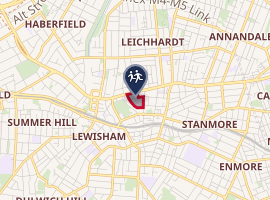
| |
To avoid confusion due to the school's history of separation, amalgamation, and eventually, its relocation; the present school is designated Fort Street High School, Petersham for official government purposes.
The school's motto is Latin: Faber est suae quisque fortunae, translated as "Each person is the maker of their own fortune", a phrase attributed to the ancient Roman Appius Claudius Caecus.
Fort Street High School has a sister school, Suginami Sogo High School, in Tokyo, Japan.[1]
In 2010 The Age reported that Fort Street High School ranked equal fourth among Australian schools based on the number of alumni who had received a top Order of Australia honour.[5][note a]
History
Creation of the Fort Street Model School
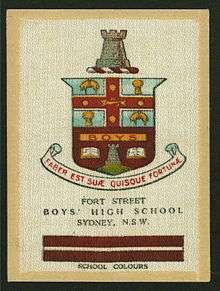
The history of public education in Australia began when the Governor of New South Wales Charles FitzRoy established a Board of National Education on 8 January 1848 to implement a national system of education throughout the Colony. The board decided to create two model schools, one for boys and one for girls. The site of Fort Street Model School was chosen as the old Military Hospital at Fort Phillip, on Sydney's Observatory Hill.[6] This school was not only intended to educate boys and girls, but also to serve as a model for other schools in the Colony. The school's name is derived from the name of a street which ran into the grounds of the hospital and became part of the playground during its reconstruction. The street name is perpetuated in the small street in Petersham that leads to the present school.[6]
Establishment of Fort Street
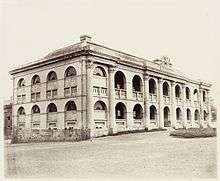
The school was officially established on 1 September 1849, when the conversion of the building was approved by the government.[6] This original school building is visible today beside the southern approaches to the Sydney Harbour Bridge. The establishment of Fort Street School marked the establishment of a non-denominational system of school, where the government undertook the education of its people, separate from religion. The influence of the Fort Street Model School was substantial, forming the basis for education throughout the colonies:
At the same time at the Fort Street National School in Sydney William Wilkins was teaching pupil-teachers how to lead the children of New South Wales out of darkness into the light. He was holding out to them that bright prospect of the day when every locality however remote and every family however humble was supplied with the ameliorating influences of an education, which would teach every man, woman and child in the colony to form the habits of regularity, cleanliness, orderly behaviour, and regard for the rights of both public and private property, as well as the habit of obedience to the law, and respect for duly constituted authority. In Melbourne, Adelaide and Hobart his counterparts were preaching the same gospel of humanity marching forward, reaching upward for the light. – Manning Clark, A History of Australia, Vol. 4, The Earth Abideth Forever 1851–1888
In 1881, the school was raised to the status of Superior Public School.[7]
Formation of Fort Street Public, Boys' High, and Girls' High Schools
In 1911, the school was split into one primary and two secondary schools: Fort Street Public School, Fort Street Boys' High School and Fort Street Girls' High School. Due to space limitations at Observatory Hill, in 1916, the Boys' school was moved to the school's present site, on Taverner's Hill, Petersham. The Girls' school remained at Observatory Hill until 1975, when the two schools were amalgamated to form the current co-educational school at Petersham. During that time, its grounds continued to be consumed by the growing city; for example, the Sydney Harbour Bridge, which opened in 1932, took most of the playground. Fort Street Public School remains at Observatory Hill.[6]
Recent
The school celebrated its sesquicentenary in 1999.[6] Its student population is now a diverse one; students come from over 100 suburbs in Sydney, from places as far as Hornsby, the Blue Mountains, Cabramatta, Fairfield and Canterbury, and a range of cultural backgrounds. Students past and present are referred to as "Fortians".[8]
Ronald Horan was for many years a master at the school. As well as writing foreign language textbooks, he was the author of a history of the school, Fort Street, the School which was later followed by Maroon and Silver.
The school has also undergone a variety of renovations, elevating the facilities of the school.
Campus
Fort Street High School is located on a single campus adjacent to Parramatta Road in Petersham, a suburb in the inner-west of Sydney. The school occupies almost the entire street block, and is surrounded by Parramatta Road, Palace Street and Andreas Street with access from Fort Street.[9][10]
The Petersham campus centres on the Romanesque Revival main building (formerly known to most staff and students simply as "the old block") now named the Wilkins Building[11] after William Wilkins, who played an instrumental role in the formation of the education system in New South Wales in the latter half of the nineteenth century. The other buildings include the Kilgour building, the Memorial Hall and the newest additions, the Cohen and Rowe buildings, which were completed in 2004.
School facilities include a library, a gymnasium, an oval, tennis courts, basketball courts, cricket practice nets, a canteen, and a performing arts block.
After years of campaigning for insulation, the school received funding for noise reduction technology, as it is located beneath an air corridor. Work on in the school was scheduled to start in mid-2010 and began in the Memorial Hall at the request of the school principal, Roslynne Moxham, to provide a quiet environment for exams being held in the hall including the Higher School Certificate. It was completed in January 2012, with the completion of insulation in the Wilkins and Kilgour blocks.[12]
The school's original Observatory Hill campus is now used by the National Trust of Australia.
Academics
Fort Street High School teaches all six grades of a standard secondary education in New South Wales, from year 7 to 12. It operates under the New South Wales Department of Education and Training (DET) and is registered and accredited with the New South Wales Board of Studies, and therefore following the mandated curriculum for all years. Administratively, the six grades are divided into three "Stages" of two years each: Stage 4 (years 7 and 8), Stage 5 (years 9 and 10) and Stage 6 (years 11 and 12).[13]
Years 7 to 10 are traditionally regarded as "junior" high school, and officially conclude with attainment of the School Certificate at the end of year 10. Compulsory subjects during these years are English, Mathematics, Science, History, Geography and Physical Education. In addition, Visual Arts, Drama, and Design & Technology are compulsory in years 7 and 8. Additionally, students learn two different languages in years 7 and 8. They may choose from French, German, Latin, Chinese and Japanese.
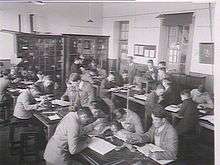
In years 9 and 10, students choose three elective subjects, from amongst Languages (Latin, French, German, Chinese, or Japanese), Elective History, Elective Geography (so-called to differentiate them from the compulsory History and Geography course), Performing Arts (Music, Drama and Visual Arts), Industrial Technologies (ICT, Woodwork, Electronics, and Food Technology), and Commerce.[13] Accelerated Maths and Business Studies, which are both accelerated subjects, can also be chosen.
In Stage 6, or years 11 and 12, students prepare for the Higher School Certificate (HSC), which certifies the completion of high school in New South Wales. In order to satisfy requirements for the HSC, each student must complete at least twelve units of study for the Preliminary course (in year 11) and at least ten units for the HSC (in year 12). The only compulsory subject is English. Students have the option of undertaking Vocational education (VET) courses, which may or may not contribute to their Australian Tertiary Admission Rank (ATAR) in the HSC.[13]
Extra-curricular activities
Sport
Fort Street High also offers sports as part of its formal and co-curricular programs. Year 7 to 10 students experience sports through the Physical Education program, and Years 8 to 11 have the option to participate in zone and knockout sports. Year 12 students are not required to undertake sport but may partake if requested. Students who are not involved in competition undertake in Year 8 skill-based sport, and in Years 9 to 11 recreational sports. Sports offered include hockey, rugby union, aerobics, basketball, ice skating, netball, soccer, water polo, cricket, squash, ice-skating, quidditch, bocce, tennis, fencing, baseball, volleyball, Oz-tag, rock climbing and touch football.[14]
Instrumental Music Program (IMP)
The Instrumental Music Program[15] is the largest co-curricular program in the school involving over 300 students. In 2002, it won the Director-General's School Achievement Award for providing opportunities for students to enrich and expand their expertise as musicians and performers.[16] The large ensembles include the Wind Ensemble, Wind Orchestra, Concert Band, Training Band, Symphony Orchestra, Philharmonic Orchestra and Vocal Ensemble. In addition, the extension ensembles include the Jazz Orchestra, Big Band, Jazz Ensemble, Percussion Ensembles, String Ensemble and Chamber Choir.
Charity Committees
Each year group has a charity committee, focusing on different issues and charities throughout the year. In 2015, the Year 8 Charity Committee (Fortians 2019) participated in the annual Seven Bridges Walk, raising over $21,000. They have established this as a tradition with subsequent years participating in the walk and raising over $10,000 per year.[17]
In 2019, the Year 9 Charity Committee hosted a toy drive for Westmead Children's Hospital. They raised over 800 toys and was congratulated on their efforts.
Robotics Club (FSHS Robotics)
FSHS Robotics[18][19] is a student-run robotics club with the aim of providing students passionate in STEM with a holistic experience of engineering from conception to production in preparation for the RoboCup Junior Australia (RCJA) competition.[20] Students primarily compete in the state and national RCJA competitions in teams consisting of 2-5 members with fully autonomous robots that they design, construct and program.
Mentored by enthusiastic teachers as well as successful senior students and alumni, students create their robots on either the LEGO Mindstorms platform with Mindstorms compatible sensors and motors, or with programmable microcontrollers - such as the Arduino family of microcontrollers - that interface with a variety of electrical components, all housed in a student-designed, mechanically functional structure. From robotics, students not only build up project management and teamwork skills but also learn a variety of useful technical skills including programming, electrical circuit design, mechanics, CAD and CAM.
At FSHS Robotics, students are provided with the opportunity to compete in the 3 main divisions offered in the RCJA competition:
- Rescue – a simulation of a rescue mission in a dangerous environment where robots rescue survivors in areas deemed too hazardous for humans to enter. In the rescue division, there are two sub-challenges:
- Rescue Line – robots must navigate an obstacle course and rescue all victims in a coloured patch, symbolising a chemical spill, before exiting the area
- Rescue Maze – robots are required to find victims indicated by coloured/heated surfaces and drop off rescue packages
- Soccer – teams face off with 2 robots each to score the most goals possible
- Dance – students and autonomous robots dance alongside each other choreographed to music
Chess
Fort Street High School offers chess as an extracurricular activity after school. Fort Street High School participates in the Metropolitan Secondary Schools Competition, a weekly inter school teams competition between secondary schools, both independent and government-funded, offered by the NSW Junior Chess League. In 2009, the senior Fort Street team became the champions of the Metropolitan Secondary Schools Competition.
Maker Society
The Fort Street High School Maker Society[21] is a co-curricular group where students can complete a variety of STEM activities. Students choose one or more STEM-related activities such as the Aeronautical Velocity,[22] STEM Video Game[23] or Formula 1 in Schools[24] challenges and work on the activity during Maker Society sessions, all under the supervision and guidance of the TAS (Technology and Applied studies) teachers. It provides a maker space and a social hub to inspire students to start their own projects.
Student Representative Council (SRC)
The student body is represented by the Student Representative Council (SRC). Four male and four female students from each year are elected by their peers at the end of the third term of each year, excepting Year 7 Representatives, who are voted in the beginning of the year. Year 11 students are elected by the SRC members as SRC president, vice-president, secretary and treasurer.
The SRC is responsible for the annual Valentine's Day Rose Drive and a Year 7 and 8 welcome dance, and are exploring more active fundraising for charity.[25] Recently, the SRC have been aiming towards fundraising to the local community, such as OASIS, a project run by the Salvation Army in Australia, and White Ribbon Australia, helping to prevent violence against women. Two delegated SRC members sit on the Fort Street High School Council (the oligarchical governing body of the school) and assist in broader decision-making processes.
The SRC also run the biennial Fort Street Festival, which allows students to open a stall at the school on the day, usually a Sunday at the beginning of June. It features a Talent Quest (previously the Battle of the Bands), a program where individuals and groups compete to win prizes. There are stalls from various student groups, including the Environment Committee, the Student Anti-Racism Network, and Amnesty International. In 2010, other stalls included Nova 96.9, NSW Police and the NSW Fire Department.[26]
Environment Committee
The Environment Committee is a student body that was formed in late 2007 by Paul Pagani, a teacher at the school. The Committee currently has over 20 members ranging from Years 7 to 11, and is led by a President. The Environment Committee works in partnership with other schools in the local area, such as Petersham Public School and Newtown High School of the Performing Arts. In a nod towards the school's heritage, the Committee worked closely with the Observatory Hill Environmental Educational Centre, including the planning of EcoTour 2010.
The Committee's past and present projects include running a Recycling Program run with the assistance of Visy Industries, installing two Water Tanks (each having a 2000L capacity),[27] installing 6 1.5 kW Solar Panels, regenerating plants with indigenous natives along Andreas Street, controlling a worm farm and running the annual Earth Hour. Future projects include a vegetable patch, a herb garden new water bottle refill stations and further recycling of aluminium and plastic.
STIVE
For more than 20 years, Fort Street High School has supported a student led and mentored, voluntary Christian program called STIVE.[28]
STIVE, abbreviated from "students alive" meets every Friday lunchtime in the school gymnasium and offers Christian focused learning and fellowship for all Fortians who wish to attend. This programme is senior student lead and delivered to the participating student body.
Stive offers a place to gather, talk and learn about the bible. It also offers food as a benefit of joining at no cost.
Walking Club
The Fort Street High School Walking Club[29] is a group where students participate in a range of high intensity exercises. Students exercise on the oval on Tuesday lunches, providing an outlet for community fitness and welfare. Jennifer Xu, the current Year Adviser for year 10, provides guidance to the students, as well as emotional support. Under her leadership, Walking Club provides a social hub to inspire students to be active and positive about exercise.
Other
Other extracurricular activities include debating (the Year 7 and 8 team was the state champion in 2010[30]), public speaking, mock trial (Fort Street was the 2009 New South Wales Champions), Tournament of Minds, Duke of Edinburgh's Award Scheme,[31] theatresports, photography, and dance.
School traditions
Fort Street utilises a house system. The school is organised into four official houses, to which each student is assigned. The houses are named after prominent alumni of the school, each representing different areas of endeavour: Barton, named after Edmund Barton, the first Prime Minister of Australia; Mawson, named after Douglas Mawson, Antarctic explorer; Kennedy, named after athlete Clarice Kennedy; and Preston, named after artist Margaret Preston.
Since 1899, the school has published the Fortian magazine, the school's annual review and yearbook. The name later came to refer to all students of the schools past and present.[32] An extensive alumni network is maintained through the school's alumni association, the Fortians' Union, formed by the amalgamation of the Old Boys' Union and the Fort Street Old Girls' Union. In addition to maintaining the alumni network, the Union also assists the school and promotes its traditions. It holds an annual dinner each October, with some student reunions held concurrently with this event.[33] The Fortians' Union publishes Faber Est, a monthly newsletter.
An annual Speech Day is held near the beginning of each year at which student achievements are recognised and awards are presented. An address is given by a prominent Fortian. In the past, Speech Day events have been held at various venues, including the school's Memorial Hall and the Sydney Opera House.[32] In recent years, the ceremony has been held at Sydney Town Hall.
Throughout its history, the various Fort Street schools have had a number of school songs.[34] At present, at assemblies, the simply-named School Song which is Come Let the Strains resound that Echo Fort Street's Glory and Gaudeamus igitur are sung at the beginning of assemblies, with Fort Street's Name Rings Around the World sung as the recessional, at its conclusion.
The FLOP, an annual student revue performed by outgoing Year 12 students, was performed for many years, beginning in 1976.[35] It usually involved humorous sketches, often parodying school life and teachers, and, in its final years, the primary medium had been video. Musical pieces, both serious and funny, were often performed. In its finalt years, various restrictions were imposed on the FLOP, including a ban on the use of cars in videos, and a requirement for videos to not include swearing. As of 2010, the FLOP has been permanently cancelled. In line with Fort Street students' long history of being a prominent source of progressive activism in Australia,[36] the decision was fiercely contested by student-led protest groups.
Fort Street community
Alumni
Fort Street alumni, as well as current attendees, are traditionally called "Fortians". Other prominent former students include two Prime Ministers of Australia, one of them being Edmund Barton, a Governor-General of Australia, and five justices of the High Court of Australia (including Michael Kirby), the highest number amongst government schools in Australia and the second highest amongst all schools in Australia. Fortians have also served as the President of the United Nations General Assembly (H. V. Evatt) and the President of the International Court of Justice (Percy Spender) (in each case, the only Australians to date to hold such positions), justices of the Supreme Court of New South Wales, Federal Court of Australia and other state and federal courts, Premiers of New South Wales, and Chancellors of the University of Sydney, the University of New South Wales and other universities. Among its graduates are also well known celebrities. In 2010 The Age reported that Fort Street High School ranked equal fourth among Australian schools based on the number of alumni who had received a top Order of Australia honour.[5]
Fort Street Foundation
The Foundation was established by some Fortians of the class of 1949. The Foundation provides a means of raising funds for the school via a separate, incorporated entity. The Foundation administers three trust funds: Library and Building (tax deductible) and the Education Fund.
Parents and Citizens Association
The Parents and Citizens Association, or "P&C", is a forum where parents of students can participate in the governance of the school. Its goals including promoting support for public education, community awareness of the school, participation of parents, interaction with school staff, and general support for the school. The P&C supports improvement of the school's physical environment, communication through the Mercurius newsletter and the school website, and fundraising activities.
See also
- List of Government schools in New South Wales
- List of selective high schools in New South Wales
- List of Fortians
References
- 姉妹校関係締結の調印式 (in Japanese). Suginami Sogo High School. Archived from the original on 13 May 2010. Retrieved 30 July 2009.
- "School Profile 2017 – Fort Street High School". My School (ACARA).
- Clark, Manning. A History of Australia: The Earth Abideth Forever 1851–1888. Vol. 4.
- Aircraft Noise Levy Collection Amendment Bill 2001: Second Reading Archived 9 November 2007 at the Wayback Machine
- Topsfield, Jewel (4 December 2010). "Ties that bind prove a private education has its awards". The Age. Australia. p. 11.
- "History". Fort Street High School. Archived from the original on 29 June 2009. Retrieved 30 July 2009.
- "Our Proud History". Fort Street Public School. Retrieved 18 November 2015.
- "Introduction". Fort Street High School. Retrieved 30 July 2009.
- "BUILDINGS AND WORKS". The Sydney Morning Herald (24, 448). New South Wales, Australia. 16 May 1916. p. 6. Retrieved 3 September 2016 – via National Library of Australia.
- "Contact Us". Fort Street High School. Retrieved 30 July 2009.
- "William Wilkins Building - Fort Street High School". Office of Environment and Heritage. Retrieved 3 September 2016.
- "Mecurius November 2011" (PDF). Fort Street High School. Archived from the original (PDF) on 19 April 2013. Retrieved 4 December 2012.
- "Curriculum". Fort Street High School. Retrieved 30 July 2009.
- "Sport". Fort Street High School. Retrieved 30 July 2009.
- https://www.fortstreet.nsw.edu.au/co-curricular/instrumental-music-program/
- The Director-General's School Achievement Award – 2002
- "2015 Fortian" (PDF). Fort Street High School. p. 85. Retrieved 18 November 2019.
- FSHS Robotics YouTube Channel
- "Robotics - Fort Street High School". Fort Street High School. Retrieved 8 February 2018.
- RoboCup Junior Australia
- https://www.fortstreet.nsw.edu.au/co-curricular/science-technology-mathematics/
- http://iiate.asn.au/events/aeronautical-velocity-challenge
- https://www.stemgames.org.au
- https://rea.org.au/f1-in-schools
- Fort Street High School – SRC
- "Fort Street Festival 2010". Fort Street High School. Archived from the original on 22 August 2011. Retrieved 4 March 2012.
- Current Projects - Fort Street High School Environmental Council
- "Student Interest Groups". Retrieved 29 July 2019.
- "Sport - Fort Street High School". Retrieved 24 September 2019.
- "Arts Unit Debating Results". Arts Unit. Archived from the original on 9 March 2011. Retrieved 29 July 2011.
- "Duke of Edinburgh Award". Fort Street High School. Archived from the original on 6 July 2011. Retrieved 30 July 2009.
- Horan (1999)
- Fortians Union – Fort Street High School (retrieved 16 October 2007)
- Fort Street Songster, Fort Street High School, Petersham, c1985, p. 21
- Horan (1990)
- Campbell, C. (2005). Changing school loyalties and the middle class: A reflection on the developing fate of state comprehensive high schooling. Australian Educational Researcher, 32(1), 3–24.
Notes
- ^a : The hard copy article also published a table of the schools which were ranked in the top ten places, as follows:
- 1st with 19 awards – Scotch College, Melbourne
- 2nd with 17 awards – Geelong Grammar School
- 3rd with 13 awards – Sydney Boys High School
- equal 4th with 10 awards each – Fort Street High School, Perth Modern School and St Peter's College, Adelaide
- equal 7th with 9 awards each – Melbourne Grammar School, North Sydney Boys High School and The King's School, Parramatta
- equal 10th with 6 awards each – Launceston Grammar School, Melbourne High School, Wesley College, Melbourne and Xavier College.
Further reading
- Horan, Ronald S. (1999). Maroon and Silver – Fort Street Sesquicentenary 1849–1999. Sydney: Honeysett Press. ISBN 0-9587276-2-7.
- Morris, Clarice (1980). The School on The Hill. Sydney: Morris Publishing. ISBN 0-9593915-0-9.
- Horan, Ronald S. (1990). Fort Street. Sydney: Geographics. ISBN 0-9592229-4-4.
External links
- Fort Street High School website
- NSW Department of Education and Training: Fort Street High School
- Foreword by Justice Kirby in the sesquicentenary book, Maroon and Silver